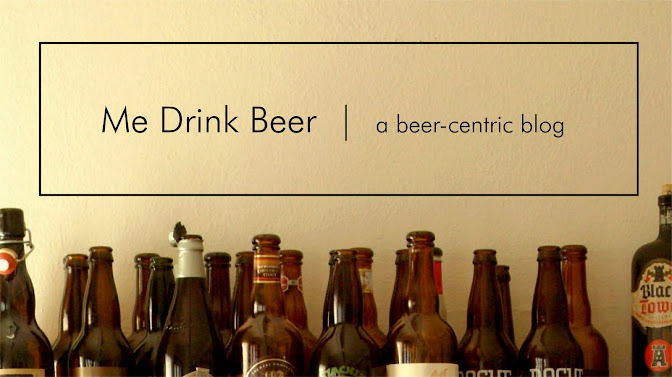I know little about Samuel Adams Chocolate Bock. What I do know is that 1.) it is magically delicious. Lucky Charms could only live up to their slogan if those tiny horseshoes and red balloons were drowning in a bowl of this chocolaty beer. And 2.) it is suffering from a mind-boggling identity crisis. More on number two later.
Having sampled this beer multiple times before, all in better states of freshness, I will admit that I was skeptical of this two-year-old bottle possessing anything in comparison to the quality of those previous bottles. Why? Well, like fine wine, fine beers can be aged, and some styles such as barley wines, imperial stouts, and Belgian strong ales are even intended to be aged. Due to the preserving power of alcohol, generally, the higher the alcohol percentage, the longer the beer can stand up to prolonged aging. Beers under the 7% alcohol by volume range, however, usually taste best when consumed as fresh as possible. Chocolate Bock's moderate 5.5% ABV does not allow for much aging before succumbing to unpleasant off-flavors. Plus, the label on the back indicates that I should have enjoyed this beer by April 2009 for brewery fresh taste. Whoops.
Having last been released in 2008, tracking down a bottle of this beer has become like finding a gas station taquito that doesn't give you instant diarrhea. Samuel Adams does not offer any information on when Chocolate Bock will be released again. Some people claim it is released every three years, but I have not been able to find any official statement from the company to support this claim.
What I did find while scouring the world wide web net was some
Attractively packaged, an ornate silver badge embossed with the namesake graces the embossed brown bottle. Silver foil wrapping the neck hides the bottle cap. Wisconsin brewery Sprecher utilized nearly the same design on their smaller barley wine bottle.
The bottle opens up immediately with the scent of milk chocolate. The Chocolate Bock pours a deep brown color with an additional ruby hue as the glass is held to the light. A vigorous pour yields a half-inch of beige foam comprised of tightly-packed bubbles. The foam lasts only a minute before dissolving to a thin coating.
In the glass, a roasted stout-like aroma prevails alongside the mellow chocolate notes. Subtle hop aroma begins to develop from being almost undetectable in the uncapped bottle.
With the first sip, flavors of roasted barley develop in the center, transitioning to milk chocolate and sweet honey towards the end. The Chocolate Bock finishes clean with sweet chocolate flavors lingering for a minute. This smooth, full-bodied beer relies heavily on its malt characteristic, therefore hop flavor is very low with only a tinge of bitterness.
The first glass was all that was needed to completely erase my skepticism.
The second and third glasses reveal slightly more complex characteristics. Dark chocolate fills the nose accompanied by hints of vanilla, giving the second glass added depth in flavor and aroma. An increase in liquid temperature can be attributed to these changes. As the beer warms up in the glass, subtle flavors once masked by colder temperatures start to blossom, adding complexity to the Chocolate Bock. Flavor and aroma further concentrate in the final glass, enhancing the bitter chocolate notes while still maintaining a smooth chocolate finish.
Samuel Adams lists Chocolate Bock as an 'extreme beer.' While most of their extreme beers weigh in at alcohol levels ranging from 16 to 27% ABV, the term does not have to represent only beers with intense alcohol levels. Chocolate Bock's extreme quality stems from its ability to showcase a complexity akin to that of an imperial stout while operating on a sufficiently lower alcohol level.
I'm no Sherlock Holmes, nor do I try to be (I'm looking at you, Downey Jr.), but Chocolate Bock is suffering from a major identity crisis in the marketing department. The bottle manages to simultaneously contradict its own contents. While the front label reads Chocolate Bock, the back label also reads Chocolate Bock and then immediately describes the beer as an, "Ale with cocoa and natural flavor." Cocoa? True. Natural flavor? Sure. Ale? Fail. Bock is a German-style dark lager, bottom-fermented using lager yeast. Samuel Adams also confirms on their website that Chocolate Bock is fermented using a bottom-fermenting lager yeast. Unlike lager, ale is top-fermented using (what else) ale yeast. It is pretty hard to be two different things at the same time unless it is named Ru Paul. I don't want to drink Ru Paul beer. Is Ru Paul still alive?
 That same website also claims that Chocolate Bock was first brewed in 2003. It is interesting that the bottle cap boasts the beer winning a gold medal at an international beer competition in 2000. I still have not been able to find any record of this beer winning an award earlier than the year 2004. It may forever remain a mystery, like the group in Minnesota that put up the billboard of that one guy.
That same website also claims that Chocolate Bock was first brewed in 2003. It is interesting that the bottle cap boasts the beer winning a gold medal at an international beer competition in 2000. I still have not been able to find any record of this beer winning an award earlier than the year 2004. It may forever remain a mystery, like the group in Minnesota that put up the billboard of that one guy.Alright, alright. I know that I am nerding out on a seemingly unimportant semantics issue, but it is the principle of the matter. There is nothing wrong with expecting consistent quality from a brewery you respect, even if it does not have a direct impact on the flavor of the beer. That goes for any kind of company. Except for the company that makes those gas station taquitos. They're garbage.
me drink beer.


No comments:
Post a Comment